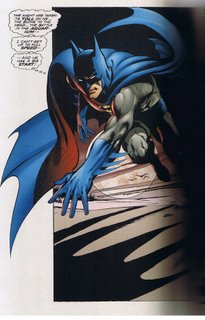

DC/Warner books has released the third and final volume of its spiffy hardcover reprint series, Batman Illustrated by Neal Adams. This volume reprints a series of stories illustrated by Adams and written by Dennis O'Neil that in my opinion represent a high mark in the character's nearly seventy-year history.
The stories have to be put into historical context. At the beginning of the sixties, Batman -- who at that time had been published for over twenty years -- was seen as practically played out. The stories (sometimes produced by creators who worked for publisher DC; other times created by ghosts who worked for Bob Kane, the nominal creator of Batman) had abandoned the mysterio version of Batman, and depicted him in increasingly silly and boring science-fiction stories. DC was actually on the verge of cancelling the Batman comics, since DC's contract with Kane made Batman comics more expensive to publish than others. Editor Julius Schwartz managed to save the character with his "New Look" Batman, which featured a more realistically drawn caped crusader -- primarily due to artist Carmine Infantino -- in less-silly stories that focused on Batman's detective skills. The Batman TV series of the mid-sixties then transformed the comic into the best-selling one in the nation; but to pander to the TV show audience, the creators camped-up the comic, writing intentionally silly stories.
When the TV series was cancelled, sales dropped, and Batman was once again in need of a new direction. DC's solution was to combine the gothic aspect of the series (which had always lurked in the background, and which was then popular due to the Dark Shadows TV series and early seventies horror movies) with a variation on the hard-boiled noir prevalent in detective novels of the time, as well as movies like Point Blank and Bullett. Batman ditched the showy Batmobile in favor of a less-conspicuous Corvette. He relied less on gadgets. He sent Robin off to college; and abandoned Stately Wayne Manor for an in-town penthouse. His repertoire of fighting moves -- previously limited to punches and the occasional kick -- expanded to various martial arts disciplines. Writer O'Neil gave him a more relaxed speech pattern that veered between knight-errant heroism and Chandler-esque cynicism, with occasional Joe-Friday-like observations, such as, "Even Criminals get old! Those who don't end up in prison, the gutter . . . or the grave!"
Best of all, Adams -- with a background in advertising art -- used his illustrator skills to redesign Batman. He gave him a sleek, gymnast's physique, a narrow jaw, a feline grace when he moved, lots of shadows, and best of all a cape that practically became another character. (Per Adams, the swirling cape was inspired by Christopher Lee's in his first Hammer Dracula movie.) As O'Neil's stories improved, Adams writes in the intro to this volume, he began experimenting with storytelling. The layouts became more cinematic, the illusion of movement more pronounced.
The O'Neil-Adams stories here were originally published from 1971-1973. I actually have the original comics, and reprints of the same stories in other volumes. But it's great to have them in one book, combined with other rare Adams stuff (such as the two Batman book-and-record sets he drew for Power Records in the mid-seventies; and his 1991 redesign of the Robin costume, in which he finally gave the poor Boy Wonder a pair of pants.) Plus, Adams and his staff (i.e., his children) re-colored these stories, and Adams did corrections on the art -- which might be bad from an historian's viewpoint; but since, as I said, all the stories are available elsewhere, the artistic tweaking is palatable.
As for the stories themselves, you get:
-- The three O'Neil-Adams stories that introduced Batman's most powerful opponent, the centuries-old ecoterrorist Ra's al Ghul (who can also be seen in last year's movie, Batman Begins.) These stories take Batman out of his familiar Gotham City millieu, and literally around the world. Decades later, O'Neil would adapt the first story, "Daughter of the Demon," for the Bruce Timm Batman animated series; and would novelize Batman Begins.
-- "Night of the Reaper," a chilling story of a vengeful Nazi hunter, done with a horror story's atmosphere.
-- "Half an Evil," the re-introduction of Batman's most Dick-Tracy-like opponent, Two-Face.
-- "The Bruce Wayne Murder Case," a story of deadly political corruption, featuring an especially cynical Batman, who saves one dirty-tricker from being murdered by another. You can see echoes of Watergate in this story.
-- My favorite, "The Joker's Five-Way Revenge." The Joker was originally introduced in 1940 as nothing less than a serial killer. Over the years, he had been softened into a mildly amusing bad guy, who stole stuff in clown-related crimes but never actually hurt anyone. That changed with this story, in which the Joker breaks out of Arkham Asylum with designs on revenge against the member of his gang who betrayed him to the police. We never learn who did so, since the Joker's approach is to simply kill all five men. Batman sets out to protect four of them -- mostly unsuccessfully. This story provided the template for numerous Joker stories to follow, as it painted the sadistic clown in operatic terms as a homicidal madman who happily poisons his men, hangs them, blows them up, and feeds them to sharks -- yet who declines to kill Batman while he lays unconscious at the Joker's feet, since doing so would be rob him of the grand confrontation he seeks.
The images above are copyrighted by DC Comics.
No comments:
Post a Comment